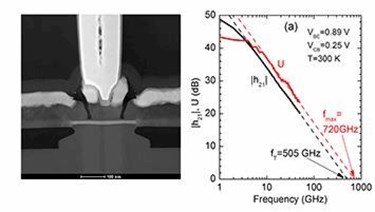IHP Presents The Fastest Silicon-Based Transistor In The World

Contribution at the renowned semiconductors conference IEDM in San Francisco
Scientist Dr. Bernd Heinemann of IHP – Innovations for High Performance Microelectronics will present results on silicon-germanium heterobipolar transistors (SiGe HBTs) developed in Frankfurt (Oder) on the “International Electron Devices Meeting” (IEDM) in San Francisco. His contribution titled “SiGe HBT with fT/fmax of 505 GHz/720 GHz” presents speed parameters that set new standards for silicon transistors.
“To present at IEDM is a valuable conclusion of the project ‘DOTSEVEN’, funded by the European Union. Together with Infineon and twelve other project partners from a total of six countries, the four-year project focused on developing SiGe HBTs with a maximum oscillation frequency, which is also referred to as fmax, of 0.7 THz,” says Dr. Bernd Heinemann, project manager at IHP. “The presented fmax values exceed the best values of current production technologies by a factor of two. Such transistors enable the realization of wire bound and wireless communication systems with even higher data rates (> 100 Gb/s). With the fast HBTs the performance of radar systems, such as in personal cars, can be increased by reducing power consumption or increasing range and spatial resolution.”
In addition, the application becomes a reality in numerous new applications, which until now have been inaccessible to silicon components and which have been reserved for, compared to silicon technologies, the less integration friendly solutions of III-V compound semiconductors. These newly emerging fields of application include imaging processes in the frequency range of 0.3 to 1 terahertz, which can be used for example for material testing, for safety inspections, for medical biopsies or for the detection of air pollution in the atmosphere. It should be emphasized that these components are compatible with established silicon technologies. Thus, they are suitable as key elements for cost-effective systems in a broad market.
The International Electron Devices Meeting (IEDM) has been the world’s preeminent forum for reporting technological breakthroughs in the areas of semiconductor and electronic device technology, design, manufacturing, physics, and modeling for more than sixty years. From December 3-7, 2016, leading scientists will present the latest research results to the international specialist audience.
About IHP:
The IHP is an institute of the Leibniz Association and conducts research and development of silicon-based systems and ultra high-frequency circuits and technologies including new materials. It develops innovative solutions for application areas such as wireless and broadband communication, security technology, biotechnology and medicine, industry 4.0, automotive industry, and aerospace. The IHP employs approximately 300 people. It operates a pilot line for technological developments and the preparation of high-speed circuits with 0.13/0.25 µm BiCMOS technologies, located in a 1000 m² class 1 cleanroom. For more information, visit www.ihp-microelectronics.com.
Source: IHP GmbH
